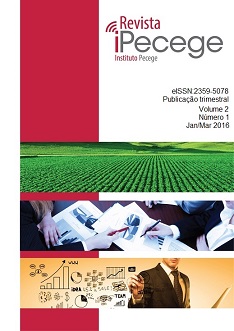Strategic management applied to the Six-Sigma suitability appraisal for R&D in FMCG companies
DOI:
https://doi.org/10.22167/r.ipecege.2016.1.80Palabras clave:
Fast Moving Consumer Goods, DMAIC, Technology Management, Total Quality ManagementResumen
This research assesses the suitability of the Six-sigma program for R&D in FMCG companies. The study also includes an analysis of its potential advantages and challenges for this business area. This was performed through data acquisition using a web-based survey targeting large scale multinational companies. Results showed that most R&D personnel within FMCG companies see Six-sigma as a positive methodology for their sector. Roughly 80% of the participants selected time saving and better knowledge allocation as the main advantages of the Six-sigma system. Almost 90% of the survey contributors believe that the series of potential benefits could lead to important scientific breakthroughs. A financial challenge is expected with the implementation and it was said to be the main concern of R&D personnel, especially from those with managerial backgrounds. Cultural changes and scientific obstacles were not reported as imminent threats to the new system. In light of the above, Six-sigma was found to be suitable for R&D in FMCG companies requiring only a few modifications in its standards and a well-defined strategic implementation plan.Descargas
Citas
Akhilesh, K. B. 2014. R&D Management. India: Springer. 253 p.
Barone, S.; Lo Franco, E. 2012. Statistical and Managerial Techniques for Six Sigma Methodology: Theory and Application. West Sussex, UK: John Wiley & Sons. 396 p.
Brun, A. 2011. Critical success factors of Six Sigma implementations in Italian companies. International Journal of Production Economics 131 (1): 158-164. doi:10.1016/j.ijpe.2010.05.008.
Chakravorty, S. S. 2009. Six Sigma programs: An implementation model. International Journal of Production Economics 119 (1): 1-16. doi:10.1016/j.ijpe.2009.01.003.
Creveling, C. M. 2002. Six Sigma for Technical Processes: An Overview for R&D Executives, Technical Leaders and Engineering Managers. NJ, USA: Prentice Hall. 351 p.
Dogra, B.; Ghuman, K. 2010. Rural Marketing: Concepts and Practices. New Delhi: Tata McGraw Hill. 350 p.
Easton, G. S.; Rosenzweig, E. D. 2012. The role of experience in six sigma project success: An empirical analysis of improvement projects. Journal of Operations Management 30 (7-8): 481-493. doi: 10.1016/j.jom.2012.08.002
Evans, J.; Lindsay, W. 2014. An Introduction to Six Sigma and Process Improvement. Stamford: Cengage Learning. 344 p.
Hamister, J. W. 2007. Impact of Category Management Practices on Performance of FMCG Supply Chains. 203 p. Ph.D. Thesis, Department of Operation Management and Strategy, The State University of New York at Buffalo, Buffalo, NY, USA.
Hemant, U. 2010. Six Sigma for Business Excellence: Approach, Tools and Applications. India: Pearson. 379 p.
Hill, C.; Jones, G. 2009. Strategic Management Theory: An Integrated Approach. Mason, USA: Cengage Learning. 528 p.
Ho, Y.-C.; Chang, O.-C.; Wang, W.-B. 2008. An empirical study of key success factors for Six Sigma Green Belt projects at an Asian MRO company. Journal of Air Transport Management 14 (5): 263-269. doi:10.1016/j.jairtraman.2008.05.002.
Jaray, S. 2005. Marketing. Ultimo, N.S.W, Australia: Career FAQs. 151 p.
Joglekar, A. M. 2003. Statistical Methods for Six Sigma: In R&D and Manufacturing. Canada: John Wiley and Sons. 344 p.
Kwak, Y. H.; Anbari, F. T. 2006. Benefits, obstacles, and future of six sigma approach. Technovation 26 (5-6): 708-715. doi:10.1016/j.technovation.2004.10.003.
McCarty, T.; Bremer, M.; Daniels, L.; Gupta, P. 2004. The Six Sigma Black Belt Handbook. United States: Mcgraw-hill. 589 p.
Nestlé. Annual Report Coorporate Report. 2014. Available in: http://www.nestle.com/aboutus/annual-report. Access: 15th Oct., 2015.
P&G. The Procter & Gamble Company Annual Report. 2015. Available in: http://www.pginvestor.com/CustomPage/Index?keyGenPage=1073748359. Access: 15th Oct., 2015.
Ryan, T. P. 2013. Sample Size Determination and Power. Canada: John Wiley and Sons. 404 p.
Subong, E. A. 2005. Statistics for Research: applications in research, thesis and dissertation writing, and statistical data management using SPSS software. Manila: Rex Bookstore, Inc. 209 p.
Taghizadegan, S. 2010. Essentials of Lean Six Sigma. United States: Elsevier Science. 304 p.
Tavana, M. 2014. Analytical Approaches to Strategic Decision-Making: Interdisciplinary Considerations: Interdisciplinary Considerations. United States: IGI Global. 417 p.
Thain, G.; Bradley, J. 2014. FMCG: The Power of Fast-Moving Consumer Goods. Sarasota, Florida: eBook Publishing. 550 p.
Tuckwell, K. J. 2008. Integrated Marketing Communications: Strategic Planning Perspectives. Canada: Pearson Prentice Hall. 440 p.
Unilever. Annual Report and Accounts Overview. Strategic Report. 2014. Available in:. https://www.unilever.com/investor-relations/annual-report-and-accounts/annual-report-and-accounts-2015-downloads.html. Access: 15th Oct., 2015.
Descargas
Publicado
Cómo citar
Número
Sección
Licencia
Os Direitos Autorais para artigos publicados nesta revista são de direito do autor. Em virtude do acesso público da revista, os artigos são de uso gratuito, com atribuições próprias, em aplicações educacionais e não-comerciais.
A revista se reserva o direito de efetuar, nos originais, alterações de ordem normativa, ortográfica e gramatical, com vistas a manter o padrão culto da língua e a credibilidade do veículo. Respeitará, no entanto, o estilo de escrever dos autores.
Alterações, correções ou sugestões de ordem conceitual serão encaminhadas aos autores, quando necessário.
As opiniões emitidas pelos autores dos artigos são de sua exclusiva responsabilidade.


